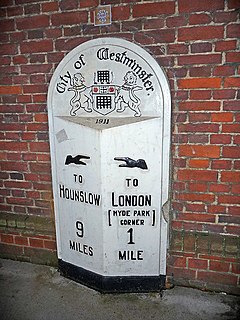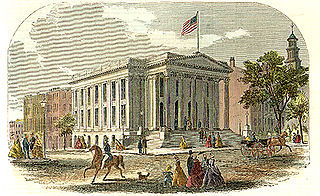Related Research Articles

The acre is a unit of land area used in the imperial and US customary systems. It is traditionally defined as the area of one chain by one furlong, which is exactly equal to 10 square chains, 1⁄640 of a square mile, 4,840 square yards, or 43,560 square feet, and approximately 4,047 m2, or about 40% of a hectare. Based upon the international yard and pound agreement of 1959, an acre may be declared as exactly 4,046.8564224 square metres. The acre is sometimes abbreviated ac, but is usually spelled out as the word "acre".

The inch is a unit of length in the British imperial and the United States customary systems of measurement. It is equal to 1/36 yard or 1/12 of a foot. Derived from the Roman uncia ("twelfth"), the word inch is also sometimes used to translate similar units in other measurement systems, usually understood as deriving from the width of the human thumb.

The imperial system of units, imperial system or imperial units is the system of units first defined in the British Weights and Measures Act 1824 and continued to be developed through a series of Weights and Measures Acts and amendments.

The metre or meter is the base unit of length in the International System of Units (SI). The SI unit symbol is m.

The mile, sometimes the international mile or statute mile to distinguish it from other miles, is a British imperial unit and US customary unit of distance; both are based on the older English unit of length equal to 5,280 English feet, or 1,760 yards. The statute mile was standardised between the British Commonwealth and the United States by an international agreement in 1959, when it was formally redefined with respect to SI units as exactly 1,609.344 metres.

Metrication or metrification is the act or process of converting to the metric system of measurement. All over the world, nations have transitioned from their local and traditional units of measurement to the metric system. This process began in France during the 1790s, and continues more than two centuries later—with the modern SI system—as the metric system has not been fully adopted in all countries and sectors.
The National Institute of Standards and Technology (NIST) is a physical sciences laboratory and non-regulatory agency of the United States Department of Commerce. Its mission is to promote American innovation and industrial competitiveness. NIST's activities are organized into laboratory programs that include nanoscale science and technology, engineering, information technology, neutron research, material measurement, and physical measurement. From 1901 to 1988, the agency was named the National Bureau of Standards.
The International System of Units, known by the international abbreviation SI in all languages and sometimes pleonastically as the SI system, is the modern form of the metric system and based on the metre as the unit of length and either the kilogram as the unit of mass or the kilogram-force as the unit of force.</ref> and the world's most widely used system of measurement. Established and maintained by the General Conference on Weights and Measures (CGPM), it is the only system of measurement with an official status in nearly every country in the world, employed in science, technology, industry, and everyday commerce.

United States customary units form a system of measurement units commonly used in the United States and U.S. territories since being standardized and adopted in 1832. The United States customary system developed from English units which were in use in the British Empire before the U.S. became an independent country. The United Kingdom's system of measures was overhauled in 1824 to create the imperial system, which was officially adopted in 1826, changing the definitions of some of its units. Subsequently, while many U.S. units are essentially similar to their imperial counterparts, there are significant differences between the systems.

The yard is an English unit of length in both the British imperial and US customary systems of measurement equalling 3 feet or 36 inches. Since 1959 it has been by international agreement standardized as exactly 0.9144 meter. A distance of 1,760 yards is equal to 1 mile.
In measurement technology and metrology, calibration is the comparison of measurement values delivered by a device under test with those of a calibration standard of known accuracy. Such a standard could be another measurement device of known accuracy, a device generating the quantity to be measured such as a voltage, a sound tone, or a physical artifact, such as a meter ruler.
The foot (pl. feet), standard symbol: ft, is a unit of length in the British imperial and United States customary systems of measurement. The prime symbol, ′, is a customarily used alternative symbol. Since the International Yard and Pound Agreement of 1959, one foot is defined as 0.3048 meters exactly. In both customary and imperial units, one foot comprises 12 inches and one yard comprises three feet.

A unit of length refers to any arbitrarily chosen and accepted reference standard for measurement of length. The most common units in modern use are the metric units, used in every country globally. In the United States the U.S. customary units are also in use. British Imperial units are still used for some purposes in the United Kingdom and some other countries. The metric system is sub-divided into SI and non-SI units.

Metrication is the process of introducing the International System of Units, also known as SI units or the metric system, to replace a jurisdiction's traditional measuring units. Although U.S. customary units have been defined in terms of metric units since the 19th century, the United States is one of only three countries that, as of 2022, have not officially adopted the metric system as the primary means of weights and measurements.
The Mendenhall Order marked a decision to change the fundamental standards of length and mass of the United States from the customary standards based on those of England to metric standards. It was issued on April 5, 1893, by Thomas Corwin Mendenhall, superintendent of the U.S. Coast and Geodetic Survey, with the approval of the United States Secretary of the Treasury, John Griffin Carlisle. The order was issued as the Survey's Bulletin No. 26 – Fundamental Standards of Length and Mass.

The link, sometimes called a Gunter’s link, is a unit of length formerly used in many English-speaking countries. In US customary units modern definition, the link is exactly 66⁄100 of a US survey foot, or exactly 7.92 inches or approximately 20.12 cm.

Ferdinand Rudolph Hassler was a Swiss-American surveyor who is considered the forefather of both the National Oceanic and Atmospheric Administration (NOAA) and the National Institute of Standards and Technology (NIST) for his achievements as the first Superintendent of the U.S. Survey of the Coast and the first U.S. Superintendent of Weights and Measures.
In common usage, the mass of an object is often referred to as its weight, though these are in fact different concepts and quantities. In scientific contexts, mass is the amount of "matter" in an object, whereas weight is the force exerted on an object by gravity. In other words, an object with a mass of 1.0 kilogram weighs approximately 9.81 newtons on the surface of the Earth, which is its mass multiplied by the gravitational field strength. The object's weight is less on Mars, where gravity is weaker, and more on Saturn, and very small in space when far from any significant source of gravity, but it always has the same mass.
The international yard and pound are two units of measurement that were the subject of an agreement among representatives of six nations signed on 1 July 1959; the United States, United Kingdom, Canada, Australia, New Zealand, and South Africa. The agreement defined the yard as exactly 0.9144 meters and the (avoirdupois) pound as exactly 0.45359237 kilograms.

The imperial and US customary measurement systems are both derived from an earlier English system of measurement which in turn can be traced back to Ancient Roman units of measurement, and Carolingian and Saxon units of measure.
References
- 1 2 Lenzen, Victor F. (1965). "The Contributions of Charles S. Peirce to Metrology" (PDF). Proceedings of the American Philosophical Society. 109 (1): 29–46. ISSN 0003-049X. JSTOR 985776. Archived from the original on 17 May 2018. Retrieved 17 May 2020.
- 1 2 3 4 Hassler, Harriet; Burroughs, Charles A., eds. (March 2007). Ferdinand Rudolph Hassler (1770-1843): A Twenty Year Retrospective, 1987-2007 (NIST Special Publication 1068) (PDF). National Institute of Standards and Technology. Archived from the original (PDF) on 18 May 2020.
- ↑ United States Senate Journal. 19: 342. May 29, 1830. Archived from the original on May 18, 2020.
- ↑ Hassler, Ferdinand Rudolph (1832). Comparison of Weights and Measures of Length and Capacity, Reported to the Senate of the United States by the Treasury Department in 1832, and Made by Ferd. Rod. Hassler (Report). Duff Green. Retrieved 18 May 2020.
- 1 2 3 4 5 Fischer, Louis A. (1905). History of standard weights and measures of the United States (PDF) (Report). National Bureau of Standards. Archived from the original (PDF) on 4 June 2018. Retrieved 20 April 2020.
- ↑ “An Act to authorize the Use of the Metric System of Weights and Measures.” 14 Stat. 339 (Chapter 301), July 28, 1866. Archived on May 17, 2020.
- ↑ "Refinement of values for the yard and the pound" (PDF), Federal Register , vol. 24, p. 5348 (24 FR 5348), 1959, archived (PDF) from the original on 17 May 2020, retrieved 17 May 2020
- ↑ "Deprecation of the United States (U.S.) Survey Foot", Federal Register , vol. 84, p. 55562 (84 FR 55562), 2019, archived (PDF) from the original on 18 May 2020, retrieved 17 May 2020